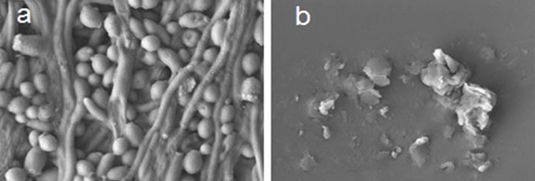Original URL: https://www.theregister.com/2013/12/09/ibm_recycles_plastic_bottles_into_lifesaving_ninja_fungus_fighters/
IBM turns plastic bottles into life-saving 'ninja' MRSA, fungus fighters
End of the line for drug-resistant killer stalking hospitals?
Posted in Science, 9th December 2013 21:21 GMT
Video IBM nanomedicine researchers working with Singapore's Institute of Bioengineering and Nanotechnology (IBN) have come up with a method for recycling plastic bottles – specifically those made with polyethylene terephthalate (PET) – to defeat drug-resistant fungal infections as well as bacterial infections such as MRSA.
"Our latest breakthrough with IBM allows us to specifically target and eradicate drug-resistant and drug-sensitive fungi strains and fungal biofilms, without harming surrounding healthy cells," said IBN executive director Jackie Ying in a statement [PDF].
IBM leveraged its chip-making nanotechnology and electrostatics expertise to develop a process in which PET-derived materials, chained together in polymer structures, carry a positive electrostatic charge. The new structures – which the researchers dub "ninja polymers" – adhere to negatively charged fungi or bacteria, and thus puncture and destroy it.
"The mechanism through which [these polymers] fight bacteria is very different from the way an antibiotic works," explains IBM polymer chemist Jim Hedrick. "They try to mimic what the immune system does: the polymer attaches to the bacteria's membrane and then facilitates destabilization of the membrane. It falls apart, everything falls out and there's little opportunity for it to develop resistance to these polymers."
The ninja polymers also take care of their own destruction, as well – after they do their work, they simply biodegrade.
The breakthrough is detailed in a paper published on Monday in Nature Communications entitled "Supramolecular high-aspect ratio assemblies with strong antifungal activity".
If a paper with an abstract that includes lines such as "Computational modelling of the terephthalamide-bisurea structures predicts zig-zag or bent arrangements where distal benzyl urea groups stabilize the high-aspect ratio aqueous supramolecular assemblies" is above your pay grade, IBM researchers teamed up with a puppeteer to create an oh-so-cutesy animation to explain the fungus-fighting properties of their ninja particles:
Ninjas vs Superbugs - Adventures in Nanomedicine
MRSA, which kills more than 19,000 victims per year in the US alone, is a particularly vicious bacterium, as is evidenced by its full name: methicillin-resistant Staphylococcus aureus. Its resistance to commonly available antibiotics make it difficult to contain or kill, and it runs particularly rampant in hospitals and other healthcare facilities.
And besides tackling that biological nasty, the IBN reports, "a particular challenge facing researchers lies in fungi's metabolic similarity to mammalian cells. Existing antifungal agents are unable to distinguish between infected and healthy cells, and frequently end up attacking the latter." As a result, patients treated with antifungal agents commonly suffer from side effects such as breakdowns in their red blood cells and kidney damage.
Since the ninja polymers work using an electrostatic mechanism, they can be specifically targeted to wreak their helpful havoc only on the fungus infections and MRSA bugs. "The result is a highly efficient killing strategy that causes minimal damage or toxicity to surrounding healthy cells," says Yi Yan Yang of IBN.

Candida albicans fungus before (a) and after (b) being attacked by the 'ninja polymers' (scale bar: 5 μm)
To be used therapeutically, the polymers are mixed with water, which is then heated to body temperature. At that point the polymers self-assemble into a hydrogel, which is easy to handle and apply to surfaces, and which can potentially be injectable and incorporated into creams.
"It is the first-ever [MRSA fighter] to be biodegradable, biocompatible and non-toxic," IBM says, "potentially making it an ideal tool to combat serious health hazards facing hospital workers, visitors and patients."
If this therapeutic breakthrough can be scaled out and made cost-effective, its impact could be enormous. As IBM notes, more than a billion people per year suffer from fungal infections globally, and BCC Research estimates that the global cost of treatments for fungal infections in humans was $10.7bn in 2011 and is projected to reach $12.2bn in 2016. ®